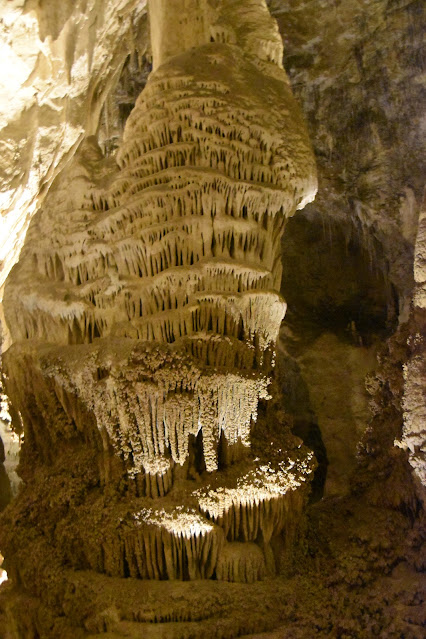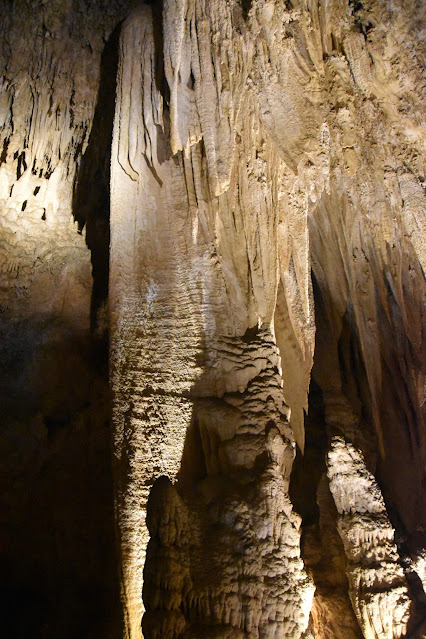Shortly after our trip to Moab, Utah we had plans to meet some friends from the Colorado jeeping group of Western Slope 4 Wheelers (WS4W) in Aztec, New Mexico searching for natural arches. So we packed up the Grand Cherokee and we started our trip which would take us to Aztec to find arches. But...why come straight home when we could explore the rest of the state of New Mexico on the way back. So we toured Santa Fe, Roswell and Carlsbad Caverns, southern New Mexico and south eastern Arizona with a goal to find arches, geocaches, caverns, historic towns and lots of diverse scenery.
Aztec, NM
We were surprised to find out that there are actually more than 300 sandstone arches in the region surrounding the city of Aztec. Friends, Ruth and Lester of WS4W, planned and guided our arch hunting adventure for two days. Overall most of the arches were accessed by dirt roads which where some what 'graded' to service the oil and gas wells throughout the area. Some arches could be seen from the road and others required short hikes. We found about 23 named/numbered arches that were on our guide list and 15 arches that we called our bonus arches (not on 'the list'). In two days we would travel down Potter, Hart, La Manga, Pump and Pilares Canyons in our quest to find arches and... indeed, we found arches.
First, what is classified as an arch. As defined by the Natural Arch and Bridge Society, "a natural arch is a rock exposure that has a hole completely through it formed by the natural, selective removal of rock, leaving a relatively intact frame.". So what you will see, are many different types of arches and below is a just some of the arches that we found.
 |
| The Colorado mountain range as a beautiful back drop |
 |
| Jeep lineup of the 'Arch Hunters' |
 |
| Hart Arch |
 |
| This arch labeled NM-031 was a pretty tough hike to get the close up photo. Extra bonus was that we found a geocache in a nearby tree. |
 |
| Happy arch hunter and geocacher. We continued hiking to Arch NM-040 which was about 24ft in length and 7ft high. |
 |
| Another photo of NM-040 from afar. |
 |
| Little Delicate Arch |
 |
| Saddle Horn Arch in Pilares Canyon |
 |
| Outcrop Arch in Potter Canyon
|
 |
Pillar Arch
|
 |
| La Manga Arch in La Manga Canyon |
 |
| Our guide, Ruth, peeking through Drum Stick Arch |
Before we departed Aztec in route to Santa Fe we visited the Aztec Ruins National Park. This massive stone structure settlement was engineered and built by ancestral Puebloans between late 1000s to the late 1200s AD. Our self guided tour along with audio narration gave us the history and detailed information on the structure and uses of each building. The buildings were mostly made of stones, mud mortar, sandstone masonry exteriors and wood roofs and consisted of over 400 rooms, ceremonial and public buildings.
 |
| Brochure photo of overall settlement |
 |
| Looking across the edge of a ceremonial kiva and the living rooms in the back ground |
 |
| The doorways were short - even for Deb. |
 |
| Inside the Great Kiva (excavated in 1921 and rebuilt in 1934). |
 |
| The wood found in place supporting the roofs in this darker area of the rooms is the original wood, that is a thousand years old. |
 |
One of many rooms displaying matates
(a ground stone tool used for processing grain and seeds) |
Great memories were made with friends. We thoroughly enjoyed visiting the Aztec Ruins and the arches in the Aztec area and hope to go back and find a couple more someday. Now it's on to Santa Fe for a couple of days.
Santa Fe
There seems to be a common word to describe Santa Fe - 'Oldest'. Santa Fe is the oldest capital city in the United States and the oldest European community west of the Mississippi. We visited the De Vargas Street house which is the oldest house in the US and also the San Miguel Chapel, a Spanish colonial mission church built in 1610, is referred to as the oldest church in the US (excluding Puerto Rico). The history is abundant in Santa Fe Historic District where we spent most of our day exploring. We had one full day and it wasn't enough to thoroughly visit all the history, arts, museums, etc. If you like adobe buildings you will like Santa Fe. This will be another place we will need to come back to to explore even more.
 |
| The Oldest standing/occupied House in United States. Exact year built is unknown but noted as 1692. |
 |
| San Miguel Church - Oldest Church structure in US. The original adobe walls and altar were built by Tlaxcalan Indians fro Mexico under the direction of Franciscan Padres in 1610 |
 |
| Interior of oldest Church |
 |
| The Cathedral Basilica of St Francis of Assisi built in 1869 |
 |
| Interior of The Cathedral Basilica |
 |
| Loretto Chapel built in the 1870's. Today it is known for the legend about it's beautiful and miraculous staircase |
 |
| Internet photo of interior of Loretto Chapel showing the self-supporting wooden staircase. |
We read that Santa Fe is known for its diverse and plentiful arts. Artists first began to migrate to Santa Fe in the late 1800s drawn to the landscape, the culture and the adobe architecture. This trend never really stopped and the city has centered a lot of the tourism around the arts. It would take days to really enjoy seeing all the different art districts in Santa Fe.
 |
Art is almost on every corner. We thought this sculpture was fun and had a good message.
You Can Do Anything * Make Every Day Count * Count Your Blessings * Always Believe in Yourself
|
 |
| Pioneer woman |
 |
| Large 'kachina' statue outside native American arts center |
Once again it's time to move on down the road. Next stop will be Roswell and Carlsbad Caverns. So stay tuned for the second half of New Mexico.
Happy Travels,
Jack & Deb





























































